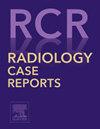A rare case of epididymal leiomyoma presenting as a chronic hemiscrotal swelling: Multimodal imaging and histopathological correlation
Q4 Medicine
引用次数: 0
Abstract
Epididymal leiomyoma is an exceptionally rare benign neoplasm originating from the smooth muscle of the epididymis. Due to its rarity and nonspecific clinical presentation, it poses significant diagnostic challenges. This case report describes a 50-year-old male who presented with a painless, progressively enlarging swelling in the right hemiscrotum over 3 years. Physical examination revealed a firm, nontender, well-demarcated swelling separate from the right testis. The initial ultrasound demonstrated a heterogeneous hyperechoic lesion with minimal vascularity on Doppler imaging, and a mild hydrocele was also noted. Further evaluation using contrast-enhanced CT revealed a heterogeneously enhancing paratesticular mass arising from the epididymis, with the right testis unaffected. The patient underwent a right-sided high inguinal orchidectomy for definitive management. Histopathological examination confirmed the diagnosis of leiomyoma, revealing interlacing fascicles of spindle cells characteristic of smooth muscle origin without evidence of malignancy. The postoperative period was uneventful, and the patient was discharged with instructions for regular follow-up. This case underscores the importance of a comprehensive diagnostic approach combining advanced imaging techniques and histopathological evaluation to accurately diagnose rare epididymal tumors. Surgical excision not only provides a therapeutic resolution but also facilitates definitive diagnosis. Awareness of such rare entities is critical for clinicians to differentiate them from other paratesticular masses, particularly malignant ones. This report adds to the limited literature on epididymal leiomyoma and highlights the need for multidisciplinary collaboration in managing such rare cases.
求助全文
约1分钟内获得全文
求助全文
来源期刊

Radiology Case Reports
Medicine-Radiology, Nuclear Medicine and Imaging
CiteScore
1.10
自引率
0.00%
发文量
1074
审稿时长
30 days
期刊介绍:
The content of this journal is exclusively case reports that feature diagnostic imaging. Categories in which case reports can be placed include the musculoskeletal system, spine, central nervous system, head and neck, cardiovascular, chest, gastrointestinal, genitourinary, multisystem, pediatric, emergency, women''s imaging, oncologic, normal variants, medical devices, foreign bodies, interventional radiology, nuclear medicine, molecular imaging, ultrasonography, imaging artifacts, forensic, anthropological, and medical-legal. Articles must be well-documented and include a review of the appropriate literature.
 求助内容:
求助内容: 应助结果提醒方式:
应助结果提醒方式:


